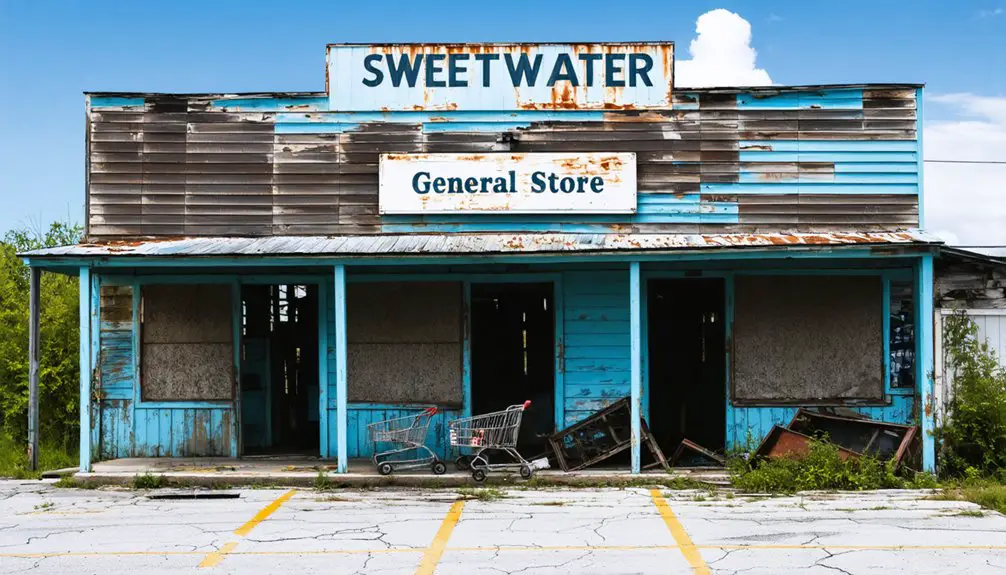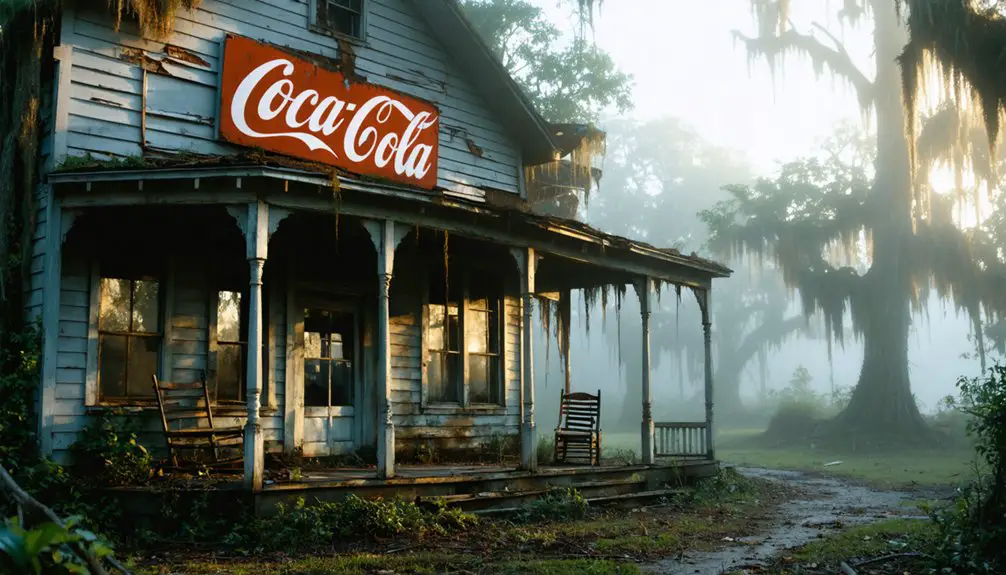You’ll discover an intriguing ghost town in Sweetwater, Florida, where 1920s land boom dreams collided with the devastating 1926 Miami Hurricane. The area found new life when Russian circus performers built custom-sized homes in the 1940s, creating a unique dwarf community. But political scandals, including a mayor’s arrest for bribery in 2013, combined with housing crises and cultural erosion, have transformed this once-vibrant town into empty streets and abandoned properties. The untold stories of Sweetwater’s decline await beneath its quiet facade.
Key Takeaways
- Population declined 11.6% in one year, leaving empty businesses and quiet streets throughout the formerly vibrant community.
- Housing inventory surged 47% year-over-year while property values dropped 9.5%, creating numerous vacant properties.
- Only 40.6% of residents own homes, indicating a transient population and lack of community stability.
- Political corruption scandals, including the mayor’s arrest for bribery, contributed to community decline and exodus.
- The original cultural identity dissolved as the Russian circus performer community dispersed and housing developments replaced mini-scaled homes.
The Curious Tale of Russian Circus Midgets
Although largely forgotten today, one of Florida’s most fascinating stories began in 1931 when a troupe of Russian circus performers of short stature arrived in America through San Francisco’s port.
After becoming U.S. citizens in 1933, they toured nationwide but faced exploitation from managers who kept most of their earnings.
By the early 1940s, they’d found refuge in Sweetwater Estates, where they built custom-sized homes and established a unique cultural impact on the area. The performers hosted regular cultural festivals that brought the community together. Originally known as the Petrograd Star Company, they had previously entertained prestigious audiences including the Romanov family.
Their community resilience shone through as they became instrumental in Sweetwater’s incorporation in 1941, with their manager Joe Sanderlin serving as the first mayor.
Despite language barriers and financial hardships, they maintained tight bonds and envisioned creating a retirement haven for little people, leaving an indelible mark on South Florida’s history.
From Ranch Land to Ghost Town
While the Florida land boom of the 1920s sparked Sweetwater’s initial development through the Miami-Pittsburgh Land Company’s purchase of “Sweetwater Groves,” the devastating 1926 Miami Hurricane brought those plans to an abrupt halt.
The roaring 1920s Florida land boom gave birth to Sweetwater Groves, until Mother Nature’s fury changed everything in 1926.
The economic downturn left numerous abandoned properties until Clyde Andrews revived interest in 1938.
Like many disambiguation place names, this Sweetwater location needed clear distinction from other similarly named towns across America.
You’d find a different Sweetwater by 1959, with just 500 residents creating new community memories in their modest town of 183 homes.
The rural ranch land had transformed into a small but functioning community with essential services – a town hall, church, grocery store, and service station.
A volunteer fire department and small police force maintained order in this quiet outpost.
The population remained stable at around 3,000 by 1970, preserving its small-town character before major regional developments changed everything.
A group of Russian circus midgets founded the town, making it one of the most unique origin stories in Florida’s history.
Political Scandals and City Hall Drama
The 2013 arrest of Sweetwater Mayor Manuel Maroño marked the beginning of an unprecedented period of political turmoil for the small city.
You’d find him charged with accepting over $40,000 in bribes for federal grant approvals, highlighting the depths of political corruption that had infected city governance.
The scandals didn’t stop there. Your city hall descended further into chaos when interim Mayor Jose M. Diaz faced sexual harassment accusations, while the FBI investigated several police officers for misconduct.
A former city employee received $66,636 in compensation after filing harassment claims against Diaz.
Police Chief Roberto Fulgueira had to address credit card fraud within his department, and two lobbyists were implicated in kickback schemes.
The once-stable leadership of Sweetwater crumbled as officials faced charges of extortion, bribery, and interference with audits, leaving the community’s trust in local government severely damaged.
Florida League of Cities president Maroño had previously served on Governor Rick Scott’s transition team before his dramatic fall from power.
Legends and Local Lore
You’ll find that Sweetwater’s origins are steeped in fascinating myths about a traveling circus that allegedly established a winter base in the area during the early 1900s.
Similar to how locally manufactured bricks were used in historic buildings of the era, the town’s infrastructure was built using materials sourced from the surrounding region.
The town’s history also includes intriguing stories of local government scandals, with rumors of missing funds and mysterious fires at city hall fueling decades of speculation.
These tales, passed down through generations of residents, have become intertwined with the supernatural legends that now define Sweetwater’s reputation as a ghost town, much like the vanished towns of Kismmet and Acron that once existed in rural Florida.
Circus Origins Myths
From humble circus beginnings grew a vibrant tapestry of local myths and legends surrounding Sweetwater’s unique founding by the Royal Russian Midgets.
The circus folklore that emerged from this remarkable settlement continues to captivate visitors and locals alike, weaving a rich community legacy that sets this town apart from surrounding Miami suburbs.
- Tales spread of a hidden “freak show” town where circus performers sought refuge from exploitation.
- The troupe’s miniaturized homes fueled stories of an entire town built to dwarf scale.
- Local legends highlight the performers’ escape from oppressive circus management.
- Stories emphasize themes of exile, loss, and the creation of a self-sufficient haven.
This distinctive heritage has inspired various media portrayals, including references in popular shows like American Horror Story: Freak Show. In 1996, mysterious reports emerged when residents claimed chupacabra attacks were responsible for unexplained animal deaths.
Government Scandal Stories
While Sweetwater’s circus origins brought whimsy to the town’s identity, its government scandals of the 1980s painted a darker picture of corruption and chaos.
You’ll find no traces of six suspended officials, including Mayor Irain Gonzalez, in City Hall’s photo displays – they’re scrubbed from history after their prison sentences for an $11,000 zoning extortion scheme.
The city’s mismanagement reached legendary proportions, much like the Lazy Nine Ranch era when socialite Osceola Davenport maintained close ties to influential political figures.
Picture a fistfight between the mayor and a councilman over unlit city hall lights, or firefighters quitting en masse when officials commandeered their engine.
Even law enforcement wasn’t immune – a former police chief faced poaching charges, while tales circulated of an early policeman who moonlighted as both councilman and burglar.
The Decline of a Unique Community

You’ll find the story of Sweetwater’s decline deeply rooted in its political scandals and failed dreams of becoming a circus-based community.
When corrupt officials and mismanagement plagued the town’s governance in the mid-20th century, residents began abandoning their homes and businesses in growing numbers.
The once-promising neighborhoods now stand empty, with deteriorating structures serving as silent witnesses to the community’s dramatic fall from hopeful beginnings to ghost town status.
From Circus to Silence
As development pressures mounted in the 1970s, Sweetwater’s distinctive identity as America’s premier dwarf community began to fade.
You’d hardly recognize the transformation from a tight-knit circus heritage settlement to a bustling Miami suburb.
The community identity eroded through:
- The dispersal of original Royal Russian Midgets troupe members and their descendants
- Rapid population growth from 500 to 3,000 residents by 1970
- An influx of Hispanic residents, particularly Nicaraguans
- The replacement of mini-scaled homes with standard housing developments
What was once a unique retirement haven for circus performers has been swallowed by urban expansion.
The establishment of Florida International University nearby and new expressways accelerated Sweetwater’s absorption into greater Miami’s suburban sprawl, leaving its colorful origins largely forgotten.
Political Scandals Doom Growth
The transformation of Sweetwater from a circus performer’s haven to a Miami suburb took an even darker turn through a series of political scandals that rocked the community from 1990 onwards.
You’ll find that corruption consequences mounted as investigations plagued the city for decades. The most damaging blow came in 2013 when Mayor Manuel Maroño accepted over $40,000 in bribes for a federal grant scheme, leading to his guilty plea and permanent ban from public office.
Governance failures continued with former Interim Mayor Jose Diaz’s sexual harassment scandal, costing taxpayers $66,000 in settlements. Since 1990, at least ten corruption investigations have targeted Sweetwater’s leadership, creating an atmosphere of distrust and stalling the city’s growth potential.
These scandals transformed a once-promising community into a cautionary tale of political misconduct.
Empty Neighborhoods, Lost Dreams
While Sweetwater once thrived as a vibrant suburb of Miami, recent years have brought stark evidence of decline throughout its neighborhoods.
The community’s resilience faces unprecedented challenges as housing affordability reaches crisis levels, with insurance premiums skyrocketing from $2,000 to as high as $8,000 annually.
You’ll find sobering signs of this decline across Sweetwater:
- Housing inventory has surged 47% year-over-year, leaving streets eerily quiet.
- Property values have dropped up to 9.5%, forcing many homeowners underwater.
- Population shrank by 11.6% in just one year, emptying local businesses.
- Homeownership stands at just 40.6%, reflecting residents’ struggle to put down roots.
These empty neighborhoods tell a story of lost dreams and fractured community bonds, as longtime residents seek more affordable places to call home.
Haunting Tales and Historical Mysteries

Shrouded in a blend of documented history and local folklore, Sweetwater’s haunting tales trace back to its unusual founding by Russian circus performers and early pioneers.
The town faced significant cultural challenges as it grew, wrestling with social stereotypes that accompanied its unique origins.
You’ll find mysterious stories woven throughout Sweetwater’s past, from the entire fire department’s dramatic resignation to a policeman-turned-burglar-turned-councilman’s peculiar career path.
There’s the legendary fistfight between Mayor Penedo and Councilman Gonzalez in 1984, and Police Chief Toledo’s documented poaching incidents.
Even the land’s earlier history raises questions, with unverified tales of a Spanish conquistador escaping Tonkawa Indians among the rocks, while the shift from Lazy Nine Ranch to modern development remains shrouded in uncertainty.
Frequently Asked Questions
Are Any Buildings From the Original Russian Circus Settlement Still Standing Today?
Like fading footprints in sand, none of the historically significant circus settlement’s architecture remains standing today. You won’t find any original buildings – they’ve all been demolished or burned over time.
What Happened to the Descendants of the Founding Circus Performers?
You’ll find the performers’ descendants integrated into Miami-Dade’s broader community, leaving their circus legacy behind. Their family stories merged with Hispanic populations as Sweetwater evolved from a specialty settlement to suburbia.
Can Visitors Legally Explore the Abandoned Areas of Sweetwater?
With 100% of Li’l Abner Park under private ownership, you can’t legally explore these abandoned areas. Urban exploration here faces strict legal restrictions and requires explicit permission from property owners or city officials.
What Is the Nearest Inhabited Town to Present-Day Sweetwater?
You’ll find Miami’s bustling metropolis is closest to Sweetwater, which isn’t actually a ghost town but a thriving city with Doral and Westchester as immediate neighbors offering modern attractions and amenities.
Did Any Businesses or Industries Survive After the Town’s Major Decline?
You won’t find any surviving ghost town businesses or industrial remnants in the area. Historical records indicate all commercial activity ceased completely during the decline, with abandoned structures marking where enterprises once thrived.
References
- https://www.miaminewtimes.com/news/as-sweetwater-turns-6363873
- https://www.sweetwaterliving.com/blog/posts-by-date/2016/march/the-history-of-sweetwater/
- https://history.howstuffworks.com/historical-events/haunted-places-in-florida.htm
- https://en.wikipedia.org/wiki/List_of_ghost_towns_in_Florida
- http://www.shrimpnfishflorida.com/forums/threads/lake-county-fl-ghost-towns.5641/
- https://kogevin.jimdoweb.com/english/russian-florida-photo-gallery/royal-russian-midgets/
- https://storymaps.arcgis.com/stories/e6318c7dbc634251b2f531bab6daebb5
- https://www.miaminewtimes.com/news/dwarves-drunks-and-horses-odd-facts-about-the-foundings-of-ten-miami-dade-towns-6524794
- https://www.instagram.com/reel/C5YeyDlrAkT/
- https://caplinnews.fiu.edu/little-people-with-big-dreams-founded-sweetwater/



